Advertisement
Experience world-renowned fishing in the waters off Mexico's Baja Peninsula. Here's how to get there based on your budget, available time, and sense of adventure.
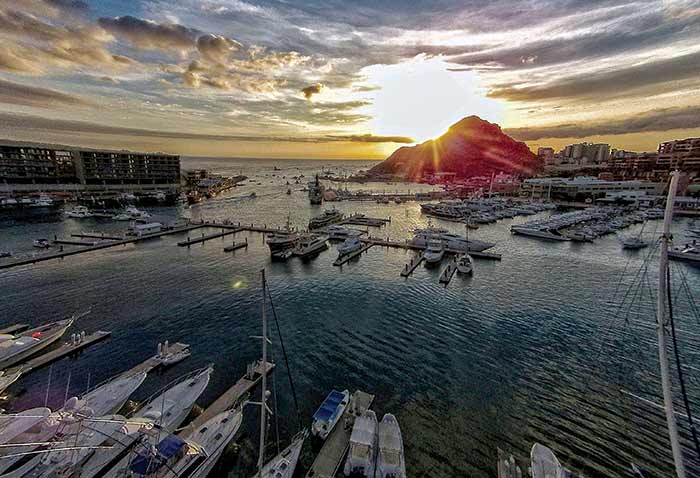
Resorts around Cabo San Lucas and San Jose del Cabo in southernmost Baja boast some impressive fleets. (Photo: Gary Graham)
For fishing fanatics, passing into Mexico is like crossing a threshold to adventure. Visitors can explore remote islands, barren coastlines, and sleepy villages while wetting their lines in some of the world's most productive waters. Rough it under the stars on a lonely beach, or pamper yourself at some of the finest five-star resorts. No matter how you prefer your adventure, though — be it laid back or luxurious — you'll have some of the world's most varied and exciting sportfishing right at your doorstep.
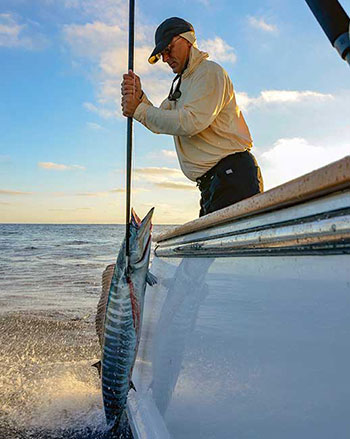
Venture farther into Baja Sur, and you'll have a shot at speed:
wahoo, giant yellowfin tuna, and striped, blue, and black marlin.
(Photo: Gary Graham)
Sparkling off Baja's eastern coastline is the Sea of Cortez, flanked by land on both sides of its 700-mile length. Also known as the Gulf of California, this narrow body of water (150 miles across at its widest point) provides different, yet equally exciting fishing for pelagic and inshore species. These waters, particularly those around the Midriff Islands at the sea's narrowest point, are renowned for jumbo-sized yellowtail, aggressive cabrilla, and giant, bottom-dwelling grouper. Sailfish, marlin, yellowfin tuna and other pelagic gamefish also make their way into the sea, particularly its southern waters near the popular sportfishing towns of Loreto and La Paz.
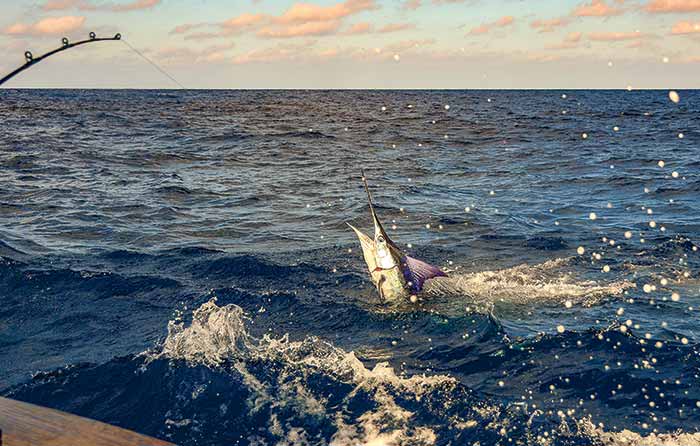
Landing a striped marlin is a thrill that will remain a memory of a lifetime. (Photo: Gary Graham)
Going Your Way
With so many places to visit and fish to catch, how do you choose what's right for you? That depends on a variety of factors, from the types of fishing you want to do to the amount of time and money you have to spend. Do you want to immerse yourself in an authentic Baja experience, complete with sleepy little villages untouched by modern technology? Or do you prefer Americanized cities where you can mix your day's fishing with gourmet dining and South Beach-style nightlife?
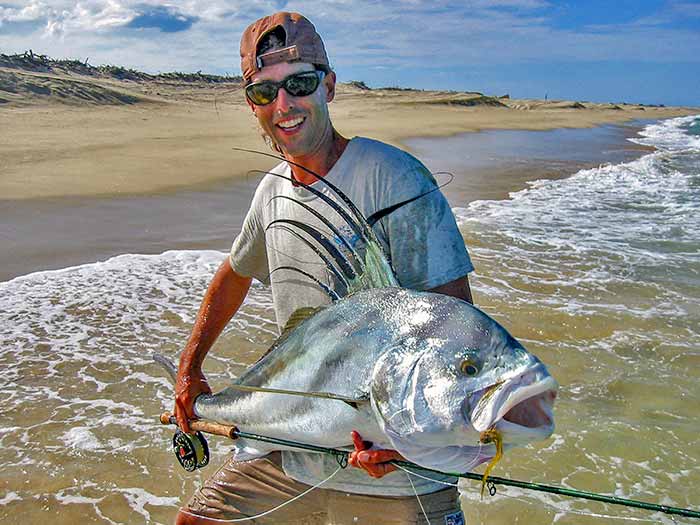
Catching and releasing a roosterfish on a fly rod from Punta Arena beach is a great challenge in the East Cape region. (Photo: Gary Graham)
The easiest way to experience Baja fishing is to fly into any of the major resort towns and arrange a chartered fishing adventure. These can range from a simple guided half-day trip aboard a panga (a simple outboard-powered open skiff) to offshore trips aboard luxurious sportfishing yachts. Onboard a panga, you'll generally fish coastal and island waters for a range of species including roosterfish, yellowtail, yellowfin tuna, dorado, cabrilla, and grouper. Depending on the location and the season, you might also have a shot at a wahoo, sailfish, or marlin.
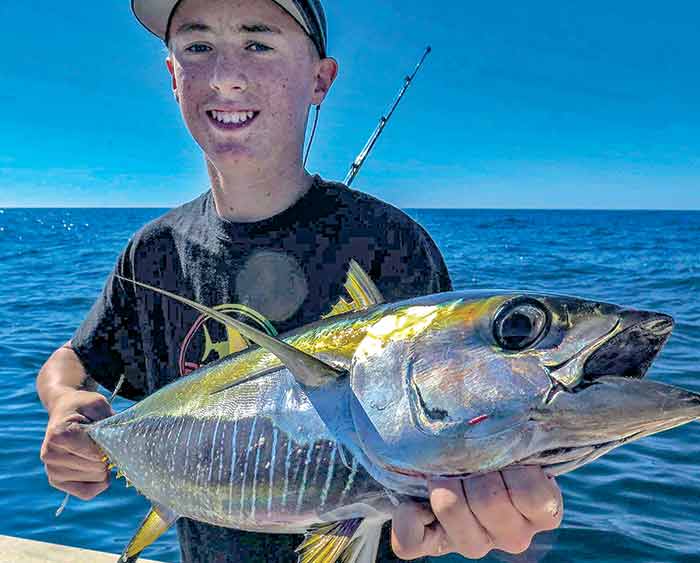
Onboard a panga, you'll generally fish coastal and island waters for a range of species. (Photo: Gary Graham)
Panga operators often do not provide fishing gear or terminal tackle — or at least tackle you'd actually want to fish with — making it a wise idea to bring your own 20- to 50-pound test outfits, lures, and hooks. Although you have all the benefits of a local expert guide, panga fishing is a hands-on experience, where the angler is actively involved in choosing which tackle to use, casting your own baits or lures, hooking your own fish, and landing it.
Sportfishing boats are charter options for fly-down anglers. Resorts around Cabo San Lucas and San Jose del Cabo in southernmost Baja boast some impressive fleets. Here, you can relax on the back deck with a frosty margarita while waiting for a wahoo, striped marlin, or perhaps even a giant blue or black marlin to crash the trolling lures. These trips are ideal for those who like to mix a little luxury with their big-game action, providing top-flight gear and full-service. The crew usually hooks the fish, hands you the rod, and you reel 'em in from a fighting chair.
Whether you book a panga, a sportfishing boat (usually a 28- to 35-foot flybridge cruiser with a cabin to get out of the weather) or a luxury yacht, these trips are a great way for anglers to "get their feet wet" and learn about Baja fishing. Anyone considering taking their own boat down to Baja should consider first doing a chartered trip or two to their planned destination.

Towing your boat to the Baja is the ultimate adventure featuring remarkable views like Hotel Loreto Bay Golf Resort & Spa. (Photo: Gary Graham)
Many of the resort hotels in towns both large and small have arrangements with local charter boats and can book your fishing and lodging at the same time. Still, some visitors prefer to walk the docks and strike their own bargains with captains to save some money. I prefer knowing whom I'm fishing with, confident in the understanding that a resort isn't likely to send its guests on a sub-par vessel. Costs can vary widely from location to location, but pangas generally go in the $250 (USD) range for an eight-hour trip for three anglers. Sportfishing boats can take up to four anglers and run in the $350 to $500 range for a full day. Chartering a yacht, which usually accommodates up to six anglers, can set you back $2,500 for a half-day and goes up from there. These are just general guidelines and don't include common additional expenditures for items like live bait, licenses, and a tip for the crew.
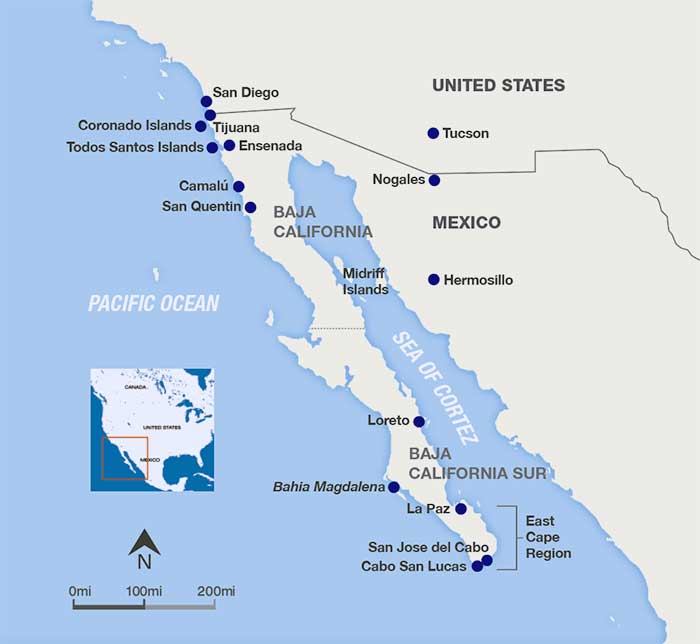
Map: Marcus Floro
"Baja-curious" anglers can also test the waters by making short excursions across the border by automobile. This can be an economical and fun way to explore quaint Baja fishing towns such as San Quintin and Camalú located on the West Coast, a half-day's drive or so south of the border crossing at Tijuana. You won't likely experience the big-game glory fishing of points farther south, but you can find excellent angling for halibut, white seabass, calico bass, rockfish, yellowtail, and in the warmer summer months, tuna and dorado. It's the same fishing one might experience on a good day off Southern California, only better as the area receives much less boat traffic and angling pressure.
Required Reading
- The Angler's Guide to Trailer Boating Baja by Zak Thomas
- Moon Baja Travel Guide by Jennifer Kramer
- Mexico Boating Guide by Capt. Pat Rains
Support the BoatUS Foundation by logging into your Amazon account at smile.amazon.com and designate BoatUS Foundation as your supporting charity. A percentage of every eligible purchase will be donated to the Foundation.
Bring Your Own Boat
Another option for a short, low-impact fishing excursion into Mexico is to run your own boat by water from San Diego. Leaving from any of the area's harbors or launch ramps, it's possible to fish your way down the coast to Ensenada, about 55 miles by sea, spend some time fishing around Todos Santos Island, and then grab a slip for the night at the Hotel Coral and Marina in Ensenada. This secure, full-service marina offers a range of guest slips with available shore power and water hookups, pumpout stations, restrooms/showers, Wi-Fi, and other amenities. As a guest of the marina, you also have access to the hotel's wonderful pool, Jacuzzi, and restaurants.
If you don't want to rough it aboard your boat overnight, book a room at the first-class Hotel Coral and start out fresh as a daisy the next morning. This makes for a great weekend boating and fishing getaway.
This area also offers some surprisingly good wineries, so you may want to make it a three-day weekend and savor some local varietals. Make sure you fuel up if needed before the run back north, as there are no waterfront services between Ensenada and San Diego.
Insurance Requirements
Mexican law requires all boaters to provide proof of liability insurance from a local provider. Boating in Mexico requires three types of insurance:
- Hull coverage
- Liability coverage issued by a Mexican insurance provider
- Automobile liability coverage issued by a Mexican insurance provider if trailering your boat on land
In the event of an auto or boating accident, Mexican law requires proof of financial responsibility, typically done by showing authorities your insurance policy. Without proof of coverage, your boat and vehicle can be impounded until you prove you weren't at fault. The Mexican government will only recognize a Mexican insurer. Visit BoatUS.com/Insurance or call 844-273-5527 to connect with a bona-fide Mexican insurer working in partnership with BoatUS to provide both boat- and auto-liability coverage for as little as one day or as long as one year. They'll provide you with the coverage and supporting paperwork so, in the event of an accident, you'll be able to show Mexican coverage.
If you have a BoatUS insurance policy for hull coverage, note that your policy requires a cruising area extension when boating in Mexico. The only exception is for bass-boat policy holders whose cruising area includes Mexico. You can obtain this extension by calling BoatUS Policy Services at 800-283-2883 as soon as you plan your trip.
— Stacey Nedrow-Wigmore
Towing Your Boat
Towing your own boat into Mexico is perhaps the ultimate Baja adventure, providing an opportunity to explore and fish remote locations at your own pace. It also requires the most planning and pre-trip homework to ensure a fun, safe, and trouble-free adventure.
Depending on your destination, you could find yourself traveling on beautiful blacktop highway or dusty, teeth-rattling washboard roads. Even on the main highways, shoulders may be narrow or nonexistent, and lighting and signage can be poor. You might also round a blind curve and find yourself face-to-face with roaming livestock, farm equipment, or heavy trucks, so you need to keep alert and focused.
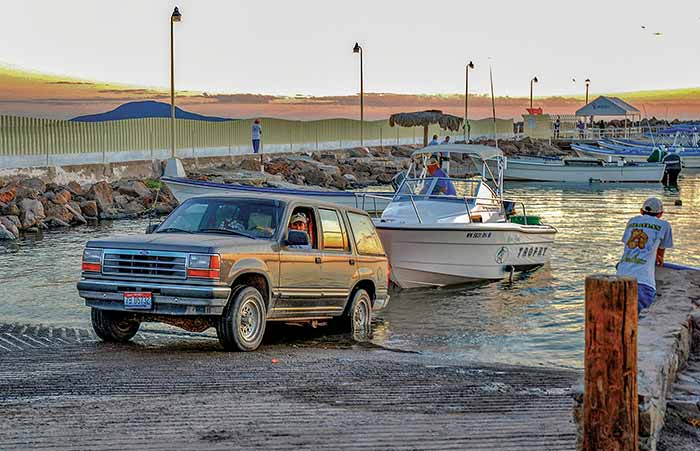
Having a paved ramp like this one at the Loreto Marina to splash your trailer boat is a luxury. (Photo: Gary Graham)
The key to a stress- and trouble-free adventure is to allow plenty of time to get from stop to stop. Even an expert like writer and photojournalist Gary Graham — who estimates he's made 300 trips up and down Baja since 1973 — avoids getting behind the wheel at night. Driving only during daylight hours and the slower pace you'll likely achieve towing a boat need to be figured into your trip planning and travel time estimation. It is always better to err on the side of leaving yourself extra time as you'll benefit from opportunities to stop, rest, and actually enjoy the stark desert and mountain scenery of this wild region along the way.
"If I'm driving into Southern Baja, I allow a minimum of two full travel days in each direction," said Graham. Considering his level of experience and familiarity with the area and its roads, it would be wise for newcomers to add at least an extra day coming and going. When you factor in ample time to kick back and enjoy the fishing, it's reasonable to plan on a 10- to 14-day trip to get the most from the journey.
Those who undertake this adventure also need to keep in mind that distances between towns and services such as gas stations, stores, and automobile/boat-repair facilities are greater than we gringos are accustomed to. Bring basic tools and spare parts.
"I bring along extra trailer wheel bearings and bearing grease, a trailer jack, a can of air, a tow cable and a well-stocked basic tool kit," said Graham. "I tow with a van, so I also take a floor jack, which makes roadside repairs even easier. I always make it a point to tighten all the lug nuts on my trailer before I leave, and recheck them frequently during the trip," Graham added.
Visually inspect your trailer before venturing south, particularly wear items like the suspension, brakes, and tires. Likewise, you'll want to make sure your tow vehicle is in good repair and up to the task. Make sure your tie-down straps are sound and that your outboard or I/O lower unit is properly supported with a towing bar to reduce wear and tear on the transom.
Additional Online Resources
- Sportfishing Association of California: Info on permits and Mexican regulations, links for boaters and anglers.
- Discover Baja Travel: Club providing insurance, road-condition updates, trip assistance, Mexican permits, maps, books, info on Baja travel.
- Vagabundos Del Mar RV: Boat and travel club focusing on Baja travel, providing access to insurance, home rentals, info, and organized Baja convoys.
- BoatUS: Offering travel and insurance resources, policy links, and member discounts at Baja resorts and marinas.
Planning, Prep, Paperwork
Depending on where you're going and how you're traveling, you may need Mexican fishing permits, FMM tourist visas, temporary boat-importation permits, and Mexican auto and boat insurance, in addition to your U.S. passport. Special wristbands are required to fish around the Coronado Islands, just across the border from San Diego. The regulations are complex and change regularly, so it's vital to do research before your trip. An article written by Graham on the popular fishing website BD Outdoors provides additional info, travel tips, and links to purchase forms and documents you'll need.
The more involved your trip, the more "homework" you'll have to do to get ready. Don't worry. This type of homework is actually fun, especially as the trip draws near and you begin to dream about those big, hard-fighting fish waiting at the end of the journey.
Advertisement
Given the rigors of towing through Baja, it comes as no surprise that anglers tend to favor simple, lightweight boats that are easy to tow and launch, efficient to run, and fairly indestructible. Outboard-powered aluminum skiffs and small center-consoles from builders like Boston Whaler, Parker, and Mako are very popular. One of the best ways to lower the stress quotient and increase the fun of towing your boat into Baja is to join one of the travel groups that coordinate Baja travel caravans. Organizations like Vagabundos del Mar and Discover Baja arrange group trips and help bring like-minded adventurers together so they can enjoy safety and security in numbers.
Some of Graham's favorite towing destinations include Loreto and La Paz on the Sea of Cortez, as well as the East Cape region, which offers both excellent offshore and inshore fishing. Trailer boaters may have to launch over the beach or have one of the local hotels surf launch the boat with their tractor (a common way of "splashing" a boat in Baja). There are some paved ramps, but these are few and far between.
Another area Graham likes to visit is Bahia Magdalena, known to sportfishing enthusiasts worldwide by its nickname "Mag Bay." Located about three-quarters of the way down Baja on the Pacific Ocean side, this remote area is most often visited by whale-watching eco tours and San Diego-based long-range sportfishers on trips of 10 days or more. There are few hotels or services, but private boaters willing to scout them out can enjoy some amazing offshore angling for giant yellowfin tuna, wahoo, and billfish.
The bay itself can be tricky to navigate with narrow channels and shifting sandbars. It's a risky move to depend solely on electronic or paper charts, so many private boaters who venture there hire a local to help them get in and out of the bay safely — a great concept for any new private boater coming to Baja. By working with a resort or walking the docks, you should be able to hire a guide/captain to accompany you on your boat. This investment provides some serious advantages. Having local knowledge on board will keep you safe and increase your chances of catching fish. It's a great opportunity to watch and learn what they do, so you can catch more fish when you go out on your own. And it's a good way to support the local economy.
Travel Tips For Baja Anglers
- Arrange with your cellphone service provider pre-trip. You may need to add international roaming.
- Tell your credit card companies (online or by phone) you'll be traveling so they don't decline a charge as a potentially fraudulent transaction.
- Stop below the border at one of the many official tourist offices (or at the airport) and purchase pesos. Alternatively, many U.S. banks will exchange currency, as will most local AAA offices if you're a member. Call at least a week ahead to ensure they have the currency available.
- Enroll your trip with the U.S. Department of State Safe Traveler Enrollment Program (STEP) to receive safety alerts and travel info and allow the U.S. Embassy to contact you in an emergency.
- Consider adding travel insurance. BoatUS partner DAN Boater offers members exclusive savings (on land or water) for the entire family for just $50 a year (a 50-percent savings). Visit danboater.org/boatus to sign up.
- Heading offshore, out of VHF range, or on a boat you don't know? Rent an EPIRB for the boat and/or PLBs for your crew from the BoatUS Foundation for a reasonable fee. Visit BoatUS.org/EPIRB for info.
